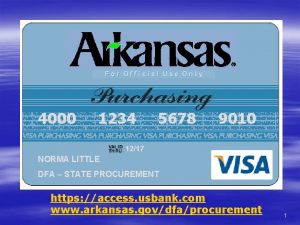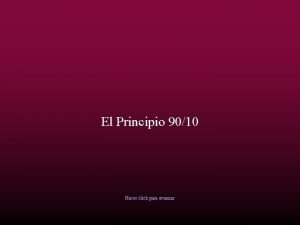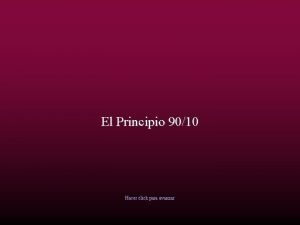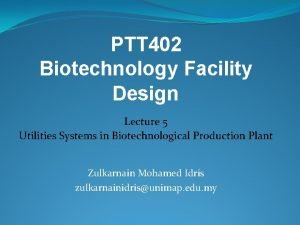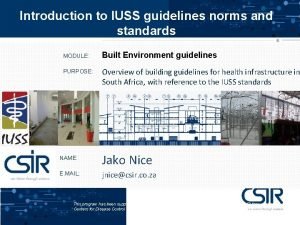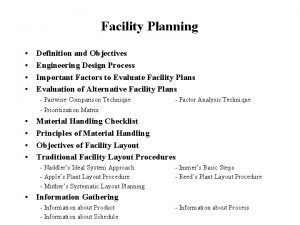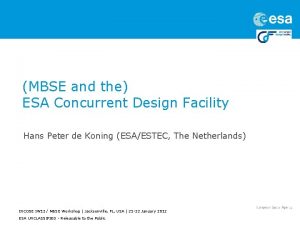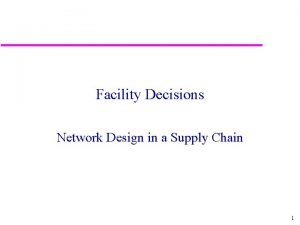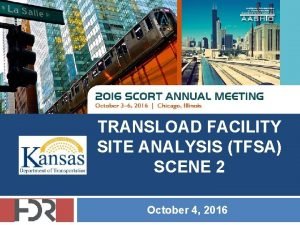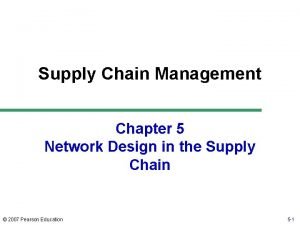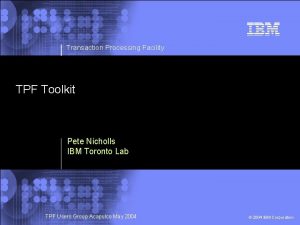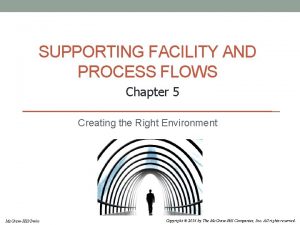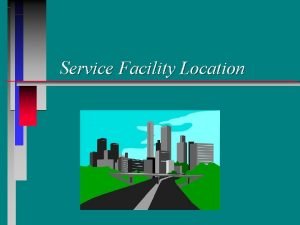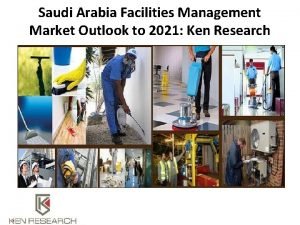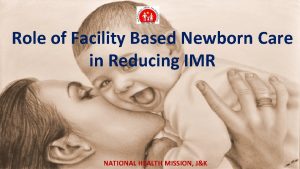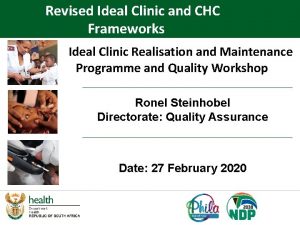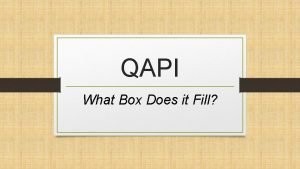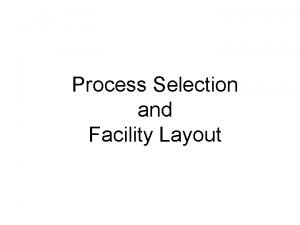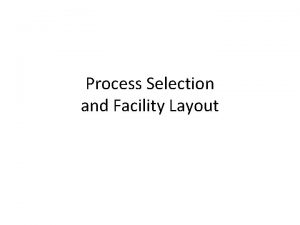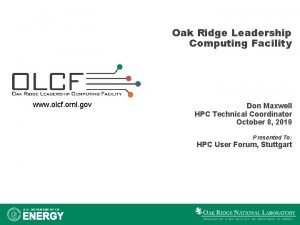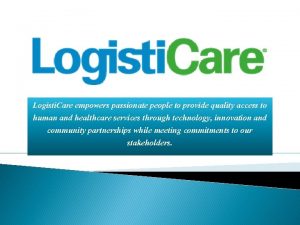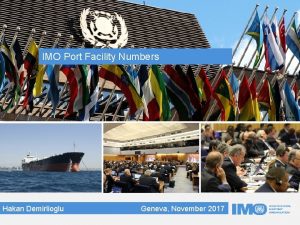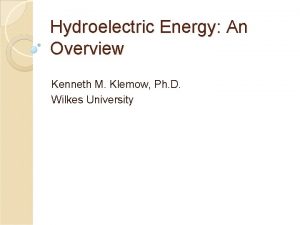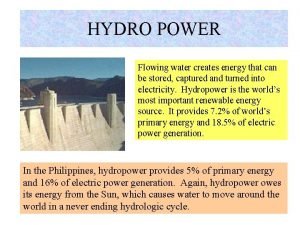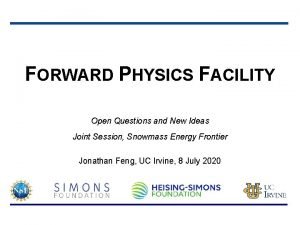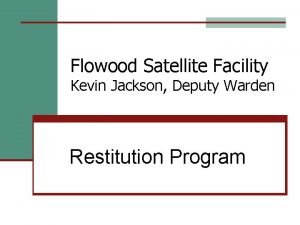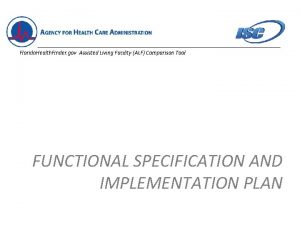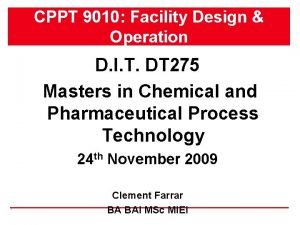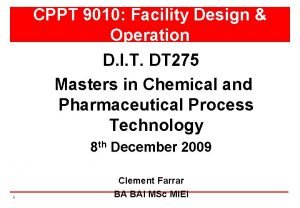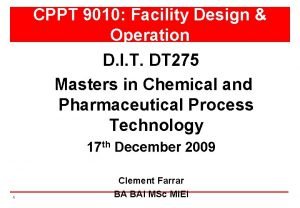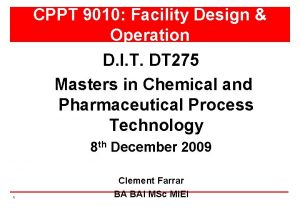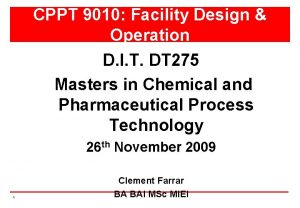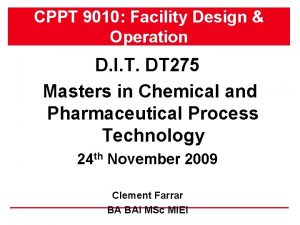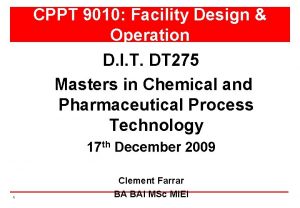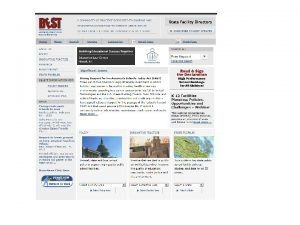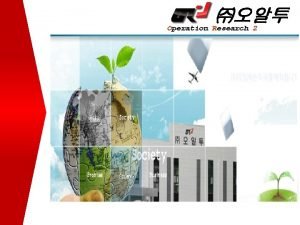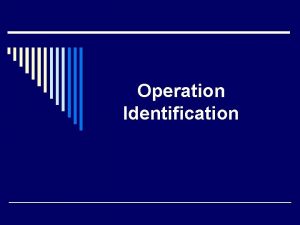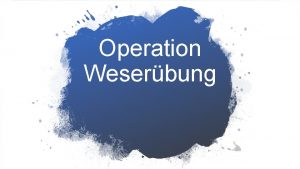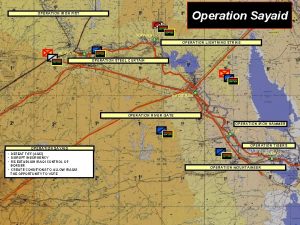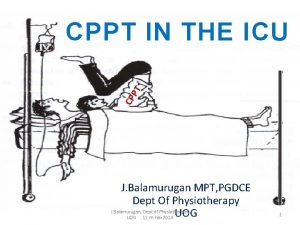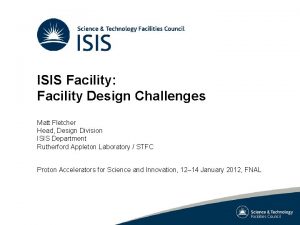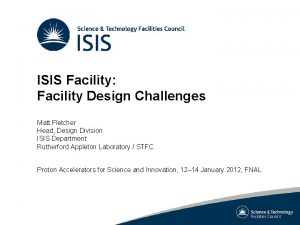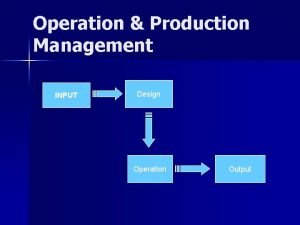CPPT 9010 Facility Design Operation D I T









































- Slides: 41

CPPT 9010: Facility Design & Operation D. I. T. DT 275 Masters in Chemical and Pharmaceutical Process Technology 26 th November 2009 1 Clement Farrar BA BAI MSc MIEI

Lecture Overview 1) Conceptual design n 2) Site Master Plan n 3) Tech Transfer n 4) Assignment Workshop n 2

Conceptual Design What is Conceptual design? n n n 3 Result of many hours brainstorming, discussion…. . Formal and structured document Fact not fiction

Conceptual Design Definition/ Purpose n n n 4 First and real quantified attempt to size, shape, program and cost an investment Provides a robust basis for investment decisions Key element in feasibility study Assists in facility location decisions Basis for assessing local infrastructure Basis for detailed design

Conceptual Design Approach n n n 5 The process is key - start with the process and provide optimal conditions Develop batch philosophy, sizing, frequency and throughput for all stages Size process elements and define space and servicing requirements Design outwards from process elements to other disciplines e. g. utilities, HVAC, E&I, Civil/ Structural/ Architectural Manage a coordinated design approach across all disciplines Collect/ collate disciplinary input for cost estimation

Conceptual Design Manufacturing Logistics n n n 6 Essential as a good basis for concept Full scale study begins with dose form and market projection based on annual patient dose and patient population Move backwards through doses, packs, lyo load, fill rate, formulation batch size, vessel size and number, innoculum, seeding etc to sees what’s required to meet the target (always allow a safety factor) Allow for qualification, cleaning, downtime, decontamination, shifts, maintenance etc. in study Move outwards from core process through CIP, Process Utilities, General Utilities etc

Conceptual Design Deliverables from Conceptual Design n n n 7 Process descriptions and PFD’s (Process flow Diagrams) (not P&ID’s) Equipment Lists, schedules and outline specs Layouts and sections with classifications Material and personnel flow studies c. GMP review HVAC schematic and philosophy Schematic for clean and general utilities Electrical load calculations and SLD Controls philosophy Cost estimate +/- 25% (typical) Project Schedule Site Plan

Conceptual Design Optional Deliverables n n n 8 Planning Package Selected Equipment Specifications Long Delivery PO’s Negotiations with utilities providers Validation Master Plan Validation input on long delivery items

Conceptual Design Develop Process n n n Remember the core purpose of the facility is to accommodate a process or processes ‘Process’ can be fermentation, DSP, formulation, fill finish or even packaging A robust process with known output requirements is a basic prerequisite PFD’s are first Engineering Description of Process Good PFD’s will show: Ø Ø Ø 9 Equipment with sizes/ duties Flows Material Balances Sequence/ Timings/ Durations Cleaning/ Process Utilities needs

Conceptual Design Equipment n n n 10 Process equipment list is a critical document – for planning, layout, costing etc Key equipment sized from manufacturing logistics and batch sizing (what is it required to do? ) Early vendor input is beneficial Size and shape of equipment needed for concept stage Configuration of process areas is based on equipment sizing and access requirements Decisions on ‘state of the art’ technology or older proven technology

Conceptual Design Critical Utilities n n n 11 Start with process utilities and direct impact systems Includes RO, WFI & Clean Steam Can also include CIP (may be part of process) Size and shape of generation plant, storage and distribution Other than CIP, which is integrated, most critical utilities need to be close/ adjacent

Conceptual Design HVAC & Classification n n 12 Critical in most areas of typical aseptic facility - more so in fill finish Have the classification discussions/ decisions early In essence, HVAC plant and distribution need to be adjoining to area served HVAC, classifications are major determinant of ultimate layout and indeed of most utilities

Conceptual Design Layers n n n 13 Apply layering concept Layers roughly correspond to classifications ‘Core’ is where critical process takes place In multi process facilities, there may be multiple cores Adjacent layers – reduced need for proximity Remote layers – not proximity dependent

Conceptual Design Preliminary Layouts n n n n 14 Developed on ‘core outward’ basis Classifications are critical - classification drawings needed Protection of process core areas – airlocks and garbing Define pre and post inactivation Separate entry and exit may be needed Return corridors Decontamination areas Corridors critical – these can dictate classifications

Conceptual Design Process Layouts n n n Sensible spacing Common sense flow patterns Ordered configuration Access for Materials, Personnel, Maintenance Engineering Aesthetics Flow Priorities are: Ø Ø 15 Materials Personnel Fluids Cable systems

Conceptual Design Buffer Make-up n n n 16 Biggest material movements in bulk processing Should be adjacent to formulation Generally larger overall volumes than core process May require material handling, dust control etc Sterile filtered at this point

Conceptual Design Clean Utilities & CIP n n n 17 CIP/ SIP are integral parts of a process design WFI generation, storage and loop distribution Clean Steam generation & distribution Significant space required CIP circuits should be as short as possible/ integrated – design for gravity return where possible

Conceptual Design Access & Communications Corridors n n n 18 Keep material movements under cover Link corridor preferred – also favour straight spine with buildings either side Warehouse is focal here – more so for fill/ finish than bulk Personnel facilities are important – significant time losses in canteen or rest room trips (smoking areas? ) Also truck access to be addressed Link corridor may be at 2 levels

Conceptual Design Warehouse/ Material Movements n n n 19 Calculate number of pallets - no shortcuts here as operations are specific Minimum level for large plant is narrow aisle with 7 -8 pallets high - requires 0. 5 m 2 per pallet Traditional low profile needs 2. 0 m 2 per pallet Decisions on receiving/ dispatch, sampling, dispensing etc Warehouse configuration drives site layout

Conceptual Design Personnel Movements n n n 20 Essential personnel only close to process (balance garbing and accommodation costs against proximity) Secondary/ tertiary garbing must be close Normal now to have separate in/ out flow passages Separate primary change/ lockers/ toilets/ showers Analyse movements – may justify multiple cafeterias, toilets, primary change areas

Conceptual Design Decisions on Height n n n 21 n Fill/ Finish height – usually single process floor Bio facility ideally at least 3 floors: Process is sandwiched between HVAC and CIP (utilities) Process utilities can be above, below or alongside Two floor process drives us to 4 floor ideal (e. g. 12500 L Vessel) Warehouse height – min 12 m Admin & other heights based on footprint

Conceptual Design Air Handling n n n n 22 Layouts and classification drive HVAC sizing HVAC plant is a big space user – plant room footprint usually exceeds total process area (top floor) Early decisions needed for walk-on concept, interstitial spaces etc Care with intakes and exhausts – allow segregation Decision re: LPHW or steam as heating medium Don’t over specify humidity limits – costly Smart recirculation policy based on energy efficiency Separate once-through needed for ‘active’ spaces

Conceptual Design Utilities – General n n n 23 Biggest user is HVAC – next is Process Utilities Assess demands for these users Size primary generation equipment – use modular approach >3 units CUB (Central Utilities Building) concept now fairly universal CUB usually remote to avoid interference with expansion plans Smart planning for pipe racks and distribution

Conceptual Design Electrical n n n 24 n Size from load list and utilities requirement Apply diversity factors based on experience Locate MCC’s adjacent to loads Decision on standby generation and scope Assess local reliability and capacity Policy on centralized versus distributed transformers Consider renewable/ sustainable

Conceptual Design Controls & Automation n n 25 Early decisions on general principles: PLC vs. DCS Similarly for scope of communication and networking Avoid ‘nice to have’ items – can result in downstream complications Similarly avoid ‘state of the art’ – usually untested and may result in unknown complications Remember need for aseptic interfaces

Conceptual Design Finishes n n n 26 Policy decision re: proprietary partition vs. traditional stud Similar decisions for floors, ceilings, doors and windows Again, remember Baselines Guides for economical solutions Proprietary partitions cost significantly more – don’t be fooled They can however save significantly in time, use of wet trades, disruption They also look better (makes facility more impressive)

Clean Room Wall Make-Up STICK BUILT Ø Cold formed Metal stud frame system. Ø Gypsum plaster board ØPlaster skim coat. ØSpray applied STERIDEX paint system. ØWall protection. MODULAR Ø High pressure laminate. (Or steel panel). 27 Advantages: Ø Theoretically more economical. Disadvantages: Ø Coordination of trades. Ø Wet & dusty construction. Ø Schedule impact Advantages: Ø Pre fabricated. Ø Quality control Ø Parallel work faces - Schedule advantage Disadvantages: Ø More expensive (Depending on system) Ø Integral wall protection. Ø Demountable.

Conceptual Design Structure/ Civil n n n 28 Design develops from layouts, height decisions, size, shape etc Site structural capability needs to be assessed Special requirements for super flat floors in warehouses etc Integrate drainage requirements – all types Site development, roads, car parks, landscaping Remember special requirements e. g. Fire Protection, Earthquake etc

Conceptual Design Cost Estimate n n n 29 Amount of effort depends on accuracy required Process Equipment costs usually based on mix of vendor enquiries and engineers database Process utilities normally costed on similar basis Process piping based on estimated run length and composite unit costs can be factored HVAC can be based on actual sizing costs for core areas and factored per square meter or cubic meter for others

Conceptual Design Cost Estimate (cont. ) n n n 30 Utilities costed on actual sizing and database costings Distribution costed on estimated length and composite costs, or can be factored Electrical costs based on points at various load sizes – derived from loads list Field Instruments based on count and category – add a premium for aseptic quality Automation costed based on I/O count Extra added for special c. GMP requirements e. g. GAMP and Part 11

Conceptual Design Cost Estimate (cont. ) n Include for: Ø Professional design – Basic & Detailed Ø Validation – C&Q Ø Construction Management Ø Permitting Ø Client Internal Costs Ø Contingency 31

Conceptual Design Schedule Critical aspect – must minimise time to market n Be realistic even though it’s years away! n Allow for decisions, approvals, n objections, contingencies n Allow for disruption and include constructability study n Beware of false assumptions on feasibility of existing site n Consult all parties early on and get agreement on big decisions n 32

Conceptual Design Summary n n 33 Apply serious front end loading at concept stage A poorly assembled concept can be a ‘milestone’ for later stages Remember even the best estimates will omit some items – allow for unforeseen On the other hand – don't kill it by being too conservative

Formulation & Vial Fill/ Finish Process FORMULATION ROOM 10 BUFFER CONJ. PREP FORMULATION VESSEL MOBILE TRANSFER VESSEL MANIFOLD Transfer Room F F WASHER VIALS REGIONAL PACKAGING DEPYRO VIAL TUNNEL FILLER VIAL STOPPER WAREHOUSE SEMI AUTO VISION SYS COLD MANUAL TRAY STORE PALLETIZER LOADER AUTOVISION SYSTEM TRAYS 34 CAPPER

Formulation and Syringe Fill/ Finish Grade C Typical Output Formulation 200, 000 Syringes Buffer Make-Up Vessel Filter Buffer Hold Vessel Filter Conjugate Download Conjugate Pooling Vessel Filter 0. 22 μm Filters Product Vessel Al. PO 4 Can Upload Filling & Inspection 1 day Grade C E-Beam Product Vessel Grade A Room/ Isolator Surge Tub Filling Vessel Sterilisation Recirculation Stoppering 2 days 35 Grade D Automated Inspection Product Ready

Syringe Filling & Inspection 36

Syringe Filling Process 37

Syringe Filling Line Layout Elevation View INFEED ISOLATOR OUTFEED Plan View 38

E-Beam Process Plan GRADE C INFEED +54 Pa E-BEAM EXHAUST GRADE C SUPPLIED E-BEAM TUNNEL PRE+44 Pa IRRADIATION GRADE A SUPPLIED E-BEAM TUNNEL POST+74 Pa IRRADIATION AIR FLOW MATERIAL FLOW POINT OF SURFACE DECONTAMINATION Plan View 39

Isolator and Outfeed Process Plan GRADE A DELID / DELINER GRADE A NESTED UDF FILL / STOPPERING GRADE A OUTFEED BUFFER GRADE C MOUSEHOLE UDF HIGH FLOW GRADE C BACKGROUND +84 Pa +54 Pa MATERIAL FLOW AIR FLOW WASTE FLOW Plan View 40

Vial Fill Finish Layout 41
 Cadet protection policy
Cadet protection policy 4000 1234 5678 9010
4000 1234 5678 9010 Principio 9010
Principio 9010 Principio 9010
Principio 9010 Principio 9010
Principio 9010 Principio 9010
Principio 9010 Steam ptt
Steam ptt Iuss standards
Iuss standards Apple's plant layout procedure
Apple's plant layout procedure Esa concurrent design facility
Esa concurrent design facility Factors influencing distribution network design
Factors influencing distribution network design Transload facility design
Transload facility design Facility role in network design
Facility role in network design Beverage line layout
Beverage line layout Objectives of good plant layout
Objectives of good plant layout System design implementation and operation
System design implementation and operation Southeastrans portal
Southeastrans portal Transaction processing facility
Transaction processing facility Sef juvenile detention
Sef juvenile detention Supporting facility example
Supporting facility example Cross median approach
Cross median approach Saudi arabia facility management market
Saudi arabia facility management market Sncuonline
Sncuonline Ideal clinic components
Ideal clinic components Rave facility
Rave facility What element of qapi addresses the culture of the facility
What element of qapi addresses the culture of the facility Importance of process selection and facility layout
Importance of process selection and facility layout Disadvantages of facility layout
Disadvantages of facility layout Olcf ornl
Olcf ornl Money supply and credit creation
Money supply and credit creation Logisticare san antonio
Logisticare san antonio Load sharing facility
Load sharing facility Imo port number
Imo port number Collins correctional facility
Collins correctional facility プラントコストインデックス
プラントコストインデックス Impoundment facility
Impoundment facility Flowing water creates energy that can be captured
Flowing water creates energy that can be captured Good laboratory practice examples
Good laboratory practice examples Forward physics facility
Forward physics facility Flowood satellite facility
Flowood satellite facility Alf locator
Alf locator Floridahealthfinder.gov/facility locator
Floridahealthfinder.gov/facility locator

